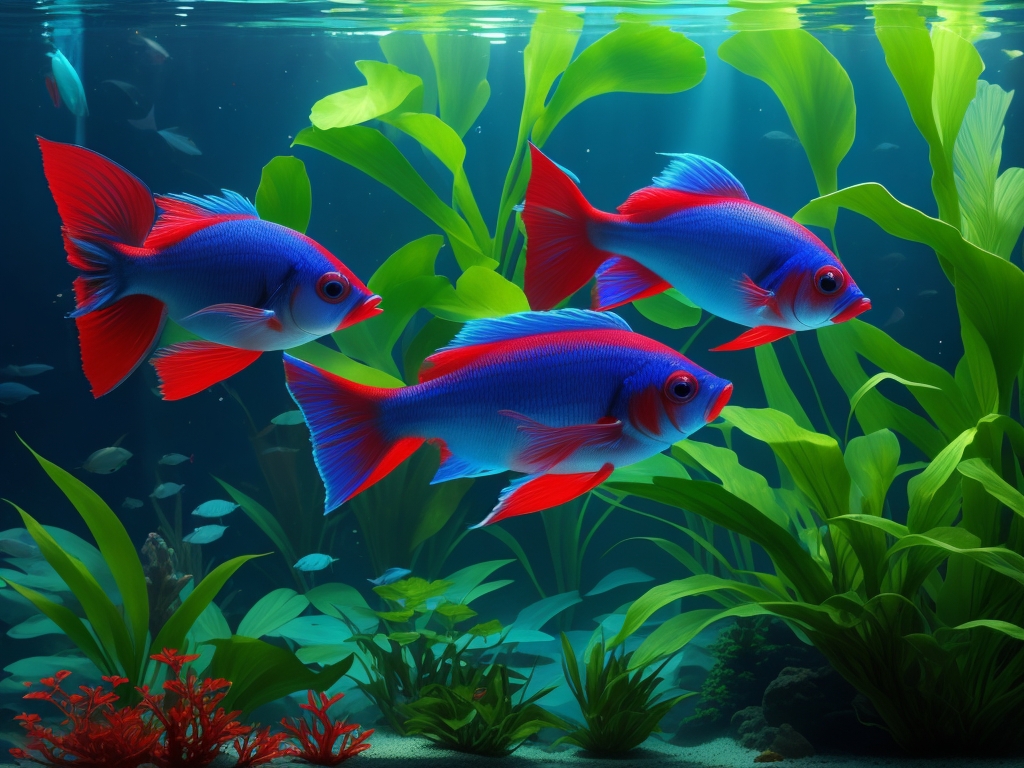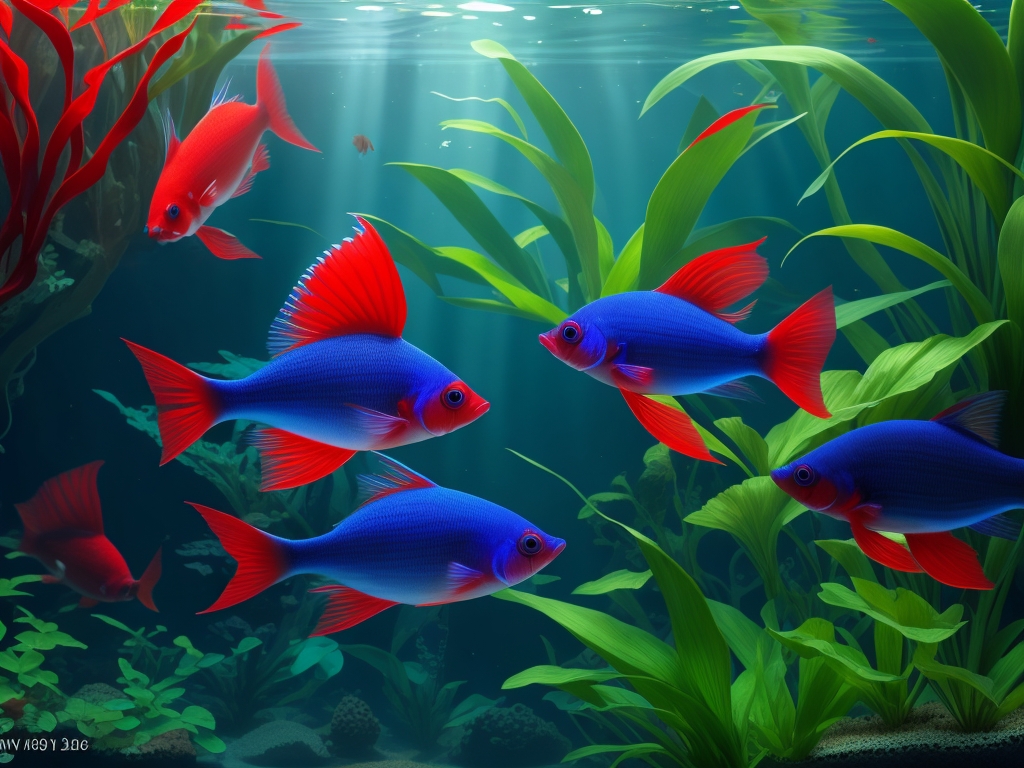If you’re looking to add a vibrant and captivating fish to your aquarium, the Cardinal Tetra might just be the perfect choice. With its stunning red and blue coloration, this small, active fish is sure to catch your eye.
Native to the Amazon River Basin, the Cardinal Tetra thrives in soft, acidic water.
In this article, we’ll delve into the habitat, physical characteristics, care, and breeding requirements of this popular aquarium fish.
Quick Facts:
- Cardinal Tetras (Paracheirodon axelrodi) are small, brightly colored freshwater fish native to the Amazon Basin of Brazil, Colombia, and Peru.
- They are closely related to another popular aquarium fish species called Neon Tetra (Paracheirodon innesi), but can be distinguished by their larger size and more intense coloration.
- Cardinal Tetras have a lifespan of 2-4 years in captivity when provided with proper care.
- These fish grow up to about 2 inches long, making them well-suited for smaller community aquariums or as part of a larger schooling group.
- They have striking vibrant colors: their body is primarily silver-blue with an iridescent red stripe that extends from their nose through their eyes and down to the base of their tail fin.
- Like many tetra species, Cardinals are highly social and should always be kept in schools of at least six individuals for their well-being.
- In terms of water parameters, they prefer slightly acidic pH levels between 5-7 and temperatures ranging from 72-82°F (22-28°C). Good water quality is essential for keeping these sensitive fish healthy.
- Cardinals feed on small insects, worms, crustaceans, and plant matter in the wild; however, they readily accept high-quality flake or pellet foods supplemented with occasional live or frozen treats such as bloodworms or brine shrimp in captivity.
- Despite being relatively peaceful within their own species and other non-aggressive community tank mates like Corydoras catfish or small characins/tetras themselves – extremes such as large cichlids may cause stress or prey upon them due to differences in behavior or mouth sizes drastically deviating weights/dimensions beyond cardinal tetra survival capacities/defensive capabilities hence unsuitable conditions bringing diseases/suffering/death resulting distress if mismatched.
- The Cardinal Tetras’ distinctive appearance and peaceful nature make them a popular choice for hobbyists who want to add vivid colors and activity to their aquariums, particularly when kept in larger schools where their brilliance truly shines.
Habitat and Natural Environment
In their natural environment, you’ll find cardinal tetras in the clear blackwater streams and rivers of the Amazon rainforest. These vibrant fish are native to South America and are well adapted to the unique conditions of their habitat.
When setting up an aquarium for cardinal tetras, it’s important to replicate their natural environment as closely as possible. This means creating a setup that mimics the blackwater conditions of the Amazon rainforest.
The water parameters should include a pH level between 4.0 and 6.0, a temperature range of 72-82°F (22-28°C), and soft, acidic water. It’s also essential to provide plenty of hiding places, such as plants and driftwood, as cardinal tetras are known to be shy and skittish.
Physical Characteristics and Coloration
You’ll notice their vibrant colors and distinctive markings.
Cardinal tetras, also known as Paracheirodon axelrodi, are small freshwater fish that are native to the Amazon basin in South America. These beautiful fish have a slender body shape and can grow up to 1.5 inches in length.

One of their most striking features is their bright red or orange-colored body, which is divided by a black horizontal stripe that spans from the nose to the base of the tail. This coloration is an evolutionary adaptation that helps them to blend into their natural habitat, which is typically densely vegetated.
The vibrant colors also play a role in their social behavior, as they use their bright markings to communicate with other members of their species, especially during courtship and territorial disputes.
Care and Tank Requirements
To properly care for cardinal tetras, make sure to provide a well-maintained tank with clean water and suitable vegetation. These beautiful fish require specific conditions to thrive. Here are some important points to consider:
- Tank Mates: Cardinal tetras are peaceful and do well in community tanks. Good tank mates include small, non-aggressive fish like rasboras, dwarf cichlids, and small peaceful catfish.
- Water Parameters: Cardinal tetras are sensitive to water conditions. Maintain a pH level between 5.0 and 7.0, with a temperature range of 74-82°F (23-28°C). It’s crucial to ensure the water is clean and well-filtered to prevent any issues.
Creating an environment that mimics their natural habitat is essential for the health and happiness of cardinal tetras. Pay attention to their tank mates and water parameters to provide the best care for these stunning fish.
Feeding and Diet
Feeding your cardinal tetras a varied diet consisting of high-quality flakes, pellets, and frozen or live foods will help keep them healthy and vibrant. Cardinal tetras are omnivorous fish, meaning they eat both plant and animal matter. Their feeding habits mainly revolve around small insects, worms, and crustaceans found in their natural habitats.
In captivity, it’s important to provide them with a balanced diet that meets their nutritional requirements. High-quality flakes should be the staple food, as they contain essential nutrients and vitamins. Pellets can also be included, as they provide additional nutrition. To mimic their natural diet, offering frozen or live foods like brine shrimp, bloodworms, and daphnia will further enhance their health and coloration.
Remember to feed them small amounts multiple times a day to prevent overeating and maintain water quality.

Breeding and Reproduction
When breeding and reproducing, it’s important to create a suitable environment with appropriate water conditions and hiding places for the fish. Cardinal tetras are known for their vibrant colors and are relatively easy to breed. Here are some breeding techniques and optimal conditions for successful reproduction:
- Provide a spacious breeding tank with a capacity of at least 10 gallons.
- Maintain a pH level between 5.5 and 7.0, and a temperature of 77 to 82 degrees Fahrenheit.
- Create a dimly lit environment by using floating plants or a black background.
To initiate breeding, introduce a group of six or more tetras and ensure a balanced ratio of males to females. Use soft, acidic water for better breeding results. Provide hiding places such as plants or caves to encourage spawning behavior. Once the eggs are laid, remove the adult tetras to prevent them from eating the eggs.
With these optimal conditions and breeding techniques, you can increase the chances of successful reproduction in cardinal tetras.
In conclusion, the cardinal tetra is a vibrant and popular fish species known for its stunning coloration and peaceful nature.
It thrives in well-maintained aquariums with plenty of hiding spots and plants to mimic its natural habitat.
Proper care and regular feeding ensure its health and longevity. With proper conditions, these fish can successfully breed in captivity.
Overall, the cardinal tetra is a fascinating addition to any aquarium, bringing beauty and tranquility to its surroundings.

